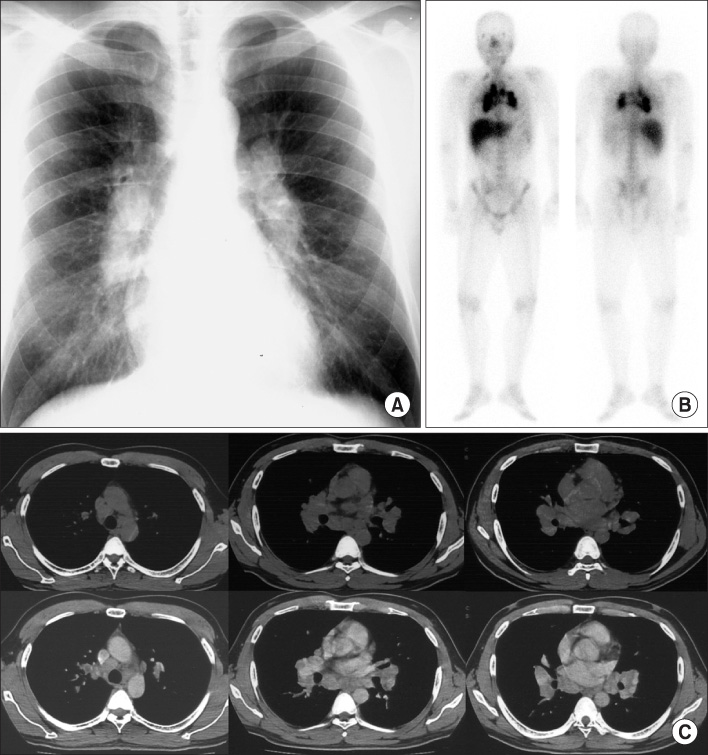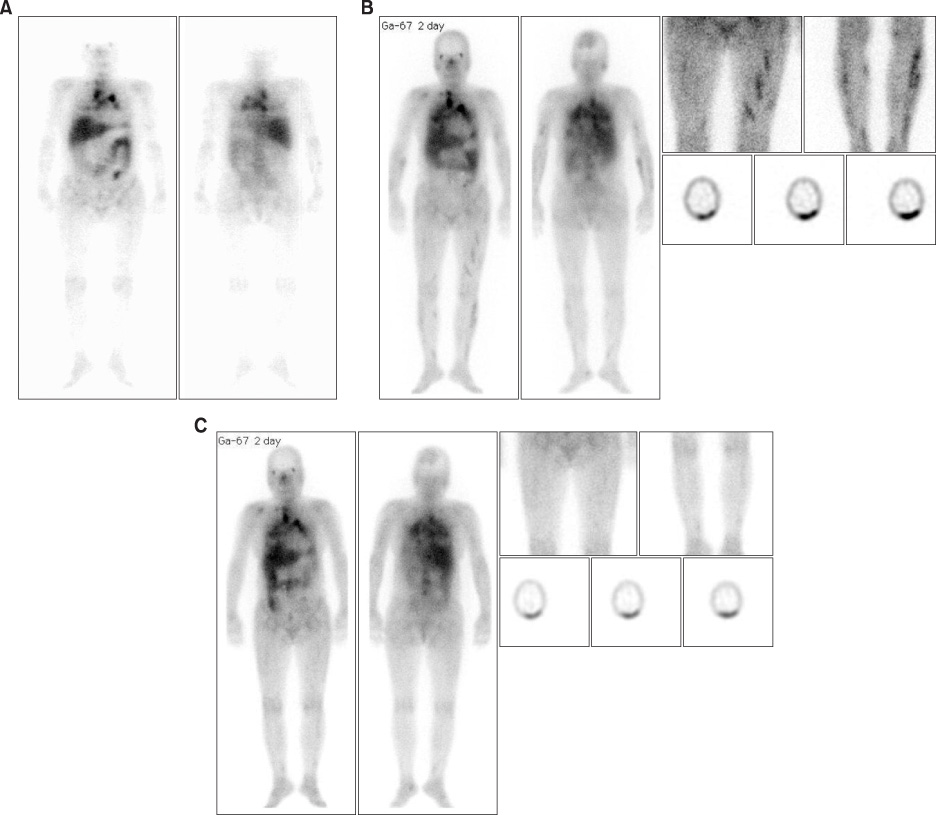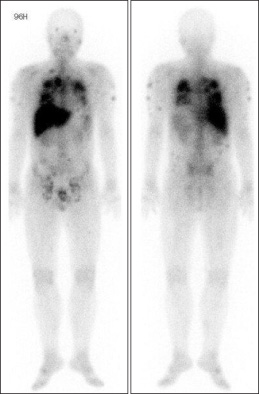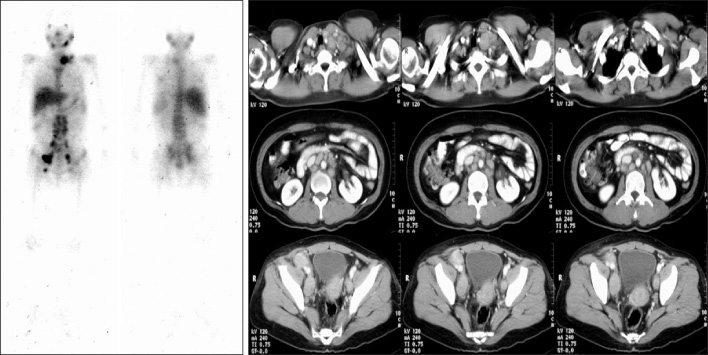Tuberc Respir Dis.
2011 Jun;70(6):504-510.
Pattern Analysis of 67Gallium Scintigraphy in Sarcoidosis
- Affiliations
-
- 1Department of Nuclear Medicine, Eulji University School of Medicine, Daejeon, Korea.
- 2Department of Nuclear Medicine, Chonbuk National University Medical School, Jeonju, Korea. stlim@chonbuk.ac.kr
- 3Cyclotron Research Center, Chonbuk National University Medical School, Jeonju, Korea.
- 4Research Institute of Clinical Medicine, Chonbuk National University Medical School, Jeonju, Korea.
Abstract
- BACKGROUND
67Ga scintigraphy has been used for years in sarcoidosis for diagnosis and to determine the extent of the disease. The present report is a study of various findings of 67Ga scintigraphy in patients with sarcoidosis.
METHODS
Between 1998 and 2007, 16 patients (male:female, 6:10; age, 35.9+/-15.3 years) with histologically proven sarcoidosis underwent clinical evaluation and 67Ga scintigraphy. According to the site of involvement, they were divided into subtypes and analyzed.
RESULTS
Sixteen patients with sarcoidosis had involvement of various organs, including lymph nodes (13/16, 81.3%), lung (3/16, 18.8%), muscle (1/16, 6.3%), subcutaneous tissue (1/16, 6.3%), glands (1/16, 6.3%), and bone (1/16, 6.3%). Sites of involved lymph nodes were thorax (12/13, 92.3%), supraclavicular area (5/13, 38.5%), inguinal area (2/13, 15.4%), abdomen (2/13, 15.4%), and pelvis (1/13, 7.7%).
CONCLUSION
Because sarcoidosis frequently involves multiple organs, 67Ga scintigraphy is a useful method in for evaluating the whole body. Nuclear medicine physicians should be familiar with the various findings of gallium uptake in sarcoidosis.
Keyword
MeSH Terms
Figure
Reference
-
1. Koyama T, Ueda H, Togashi K, Umeoka S, Kataoka M, Nagai S. Radiologic manifestations of sarcoidosis in various organs. Radiographics. 2004. 24:87–104.2. Yi GW, Koh EM, Chung JK, Lee MC, Shim YS, Koh CS. Three cases of sarcoidosis evaluated by 67Ga scintigraphy. Korean J Nucl Med. 1988. 22:93–98.3. Sulavik SB, Spencer RP, Weed DA, Shapiro HR, Shiue ST, Castriotta RJ. Recognition of distinctive patterns of gallium-67 distribution in sarcoidosis. J Nucl Med. 1990. 31:1909–1914.4. Britt AR, Francis IR, Glazer GM, Ellis JH. Sarcoidosis: abdominal manifestations at CT. Radiology. 1991. 178:91–94.5. Johnson DG, Johnson SM, Harris CC, Piantadosi CA, Blinder RA, Coleman RE. Ga-67 uptake in the lung in sarcoidosis. Radiology. 1984. 150:551–555.6. Gupta RG, Bekerman C, Sicilian L, Oparil S, Pinsky SM, Szidon JP. Gallium 67 citrate scanning and serum angiotensin converting enzyme levels in sarcoidosis. Radiology. 1982. 144:895–899.7. Sohn HS, Kim EN. A case of muscular sarcoidosis diagnosed by Gallium-67 scintigraphy and magnetic resonance imaging. Korean J Nucl Med. 1999. 33:543–548.8. Moore SL, Teirstein AE. Musculoskeletal sarcoidosis: spectrum of appearances at MR imaging. Radiographics. 2003. 23:1389–1399.9. Henry DA, Kiser PE, Scheer CE, Cho SR, Tisnado J. Multiple imaging evaluation of sarcoidosis. Radiographics. 1986. 6:75–95.10. Kim MJ, Yoo HS, Lee JT, Suh JH, Park CY, Lee DY. 67Ga of primary hepatocellular carcinoma: correlation with angiography. Korean J Nucl Med. 1989. 23:27–34.11. Tsan MF, Scheffel U. Mechanism of gallium-67 accumulation in tumors. J Nucl Med. 1986. 27:1215–1219.12. Baughman RP, Shipley R, Eisentrout CE. Predictive value of gallium scan, angiotensin-converting enzyme level, and bronchoalveolar lavage in two-year follow-up of pulmonary sarcoidosis. Lung. 1987. 165:371–377.13. Braun JJ, Kessler R, Constantinesco A, Imperiale A. 18F-FDG PET/CT in sarcoidosis management: review and report of 20 cases. Eur J Nucl Med Mol Imaging. 2008. 35:1537–1543.14. Nishiyama Y, Yamamoto Y, Fukunaga K, Takinami H, Iwado Y, Satoh K, et al. Comparative evaluation of 18F-FDG PET and 67Ga scintigraphy in patients with sarcoidosis. J Nucl Med. 2006. 47:1571–1576.
- Full Text Links
- Actions
-
Cited
- CITED
-
- Close
- Share
- Similar articles
-
- A Case of Muscular Sarcoidosis diagnosed by Gallium-67 Scintigraphy and Magnetic Resonance Imaging
- A Pulmonary Sarcoidosis Manifesting as a Rare Atypical Pattern and Distribution
- A Case of Sarcoidosis Misdiagnosed as Tuberculosis in the Early Phase
- A Case of Ichthyosiform Sarcoidosis
- A Case of Coexistent Cutaneous Sarcoidosis in a Patient with Tuberculous Pleurisy






